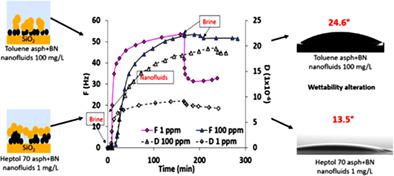当前位置:
X-MOL 学术
›
Can. J. Chem. Eng.
›
论文详情
Our official English website, www.x-mol.net, welcomes your
feedback! (Note: you will need to create a separate account there.)
Investigation of the interaction between nanoparticles, asphaltenes, and silica surfaces by real-time quartz crystal microbalance with dissipation
The Canadian Journal of Chemical Engineering ( IF 1.6 ) Pub Date : 2021-07-17 , DOI: 10.1002/cjce.24264 Tatiana Montoya 1 , Archana Jaiswal 2 , Nashaat N. Nassar 1
The Canadian Journal of Chemical Engineering ( IF 1.6 ) Pub Date : 2021-07-17 , DOI: 10.1002/cjce.24264 Tatiana Montoya 1 , Archana Jaiswal 2 , Nashaat N. Nassar 1
Affiliation

|
The effects of nanofluids as wettability alternators and inhibitors of asphaltene precipitation and formation damage were studied in this work. Silicate-based nanoparticles with different chemical surfaces, named neutral (NN), basic (BN), and acidic (AN), dispersed in NaCl brine were tested to observe their interactions with n-C7 asphaltenes and silica surfaces using the quartz crystal microbalance with dissipation (QCM-D). The properties of nanoparticles were characterized using XRD, BET, TPD, and HRTEM. Heptol 70 asphaltenes, pre-adsorbed/deposited on SiO2 sensors were used for studying the concentration effect of 10 nm-sized BN-based nanofluids, which exhibited a decreasing trend in frequency shift in the following order 1 > 10 > 25 mg/L. For toluene asphaltenes, the frequency shifts in BN nanofluids changed with the following order of concentration 100 > 150 > 50 > 25 mg/L. The effect of particle size on frequency shift, tested for toluene asphaltenes demonstrated the following order 10 > 99 > 45 > 20 nm BN. A cycle injection test between asphaltenes and a nanofluid solution was performed to evaluate the effect of the nanoparticles in a sequence injection. Wettability alteration was assessed before and after nanofluid injection using contact angle measurements, which resulted in a decrease after nanofluid injection. In addition, atomic force microscopy (AFM) measurements were performed on some of the samples to support the findings. The QSense data analysis software Q-Tools was used to determine the thickness of the layer before and after the injection of nanofluids; the trend was similar to the change in frequency for all parameters. Finally, brine-based nanofluids with 10 nm-sized BN at 1 and 100 mg/L were more effective in treating the deposited asphaltenes in heptol 70 and toluene, respectively.
中文翻译:

通过具有耗散的实时石英晶体微天平研究纳米颗粒、沥青质和二氧化硅表面之间的相互作用
在这项工作中研究了纳米流体作为润湿性交流发电机和沥青质沉淀和地层损伤抑制剂的影响。测试分散在 NaCl 盐水中的具有不同化学表面的硅酸盐基纳米粒子,命名为中性 (NN)、碱性 (BN) 和酸性 (AN),以使用石英晶体微天平观察它们与n -C 7沥青质和二氧化硅表面的相互作用耗散(QCM-D)。使用 XRD、BET、TPD 和 HRTEM 表征纳米粒子的性质。Heptol 70 沥青质,预吸附/沉积在 SiO 2 上传感器用于研究 10 nm 大小的基于 BN 的纳米流体的浓度效应,其频率偏移呈递减趋势,按以下顺序 1 > 10 > 25 mg/L。对于甲苯沥青质,BN 纳米流体中的频移按以下浓度顺序变化:100 > 150 > 50 > 25 mg/L。对甲苯沥青质进行测试时,粒径对频移的影响显示出以下顺序:10 > 99 > 45 > 20 nm BN。进行了沥青质和纳米流体溶液之间的循环注入测试,以评估纳米颗粒在顺序注入中的效果。使用接触角测量在纳米流体注射之前和之后评估润湿性改变,这导致纳米流体注射后降低。此外,对一些样品进行了原子力显微镜 (AFM) 测量以支持这些发现。使用QSense数据分析软件Q-Tools测定纳米流体注入前后的层厚;趋势与所有参数的频率变化相似。最后,具有 10 纳米尺寸 BN 的 1 和 100 毫克/升的盐水基纳米流体分别在处理庚醇 70 和甲苯中沉积的沥青质时更有效。
更新日期:2021-07-17
中文翻译:

通过具有耗散的实时石英晶体微天平研究纳米颗粒、沥青质和二氧化硅表面之间的相互作用
在这项工作中研究了纳米流体作为润湿性交流发电机和沥青质沉淀和地层损伤抑制剂的影响。测试分散在 NaCl 盐水中的具有不同化学表面的硅酸盐基纳米粒子,命名为中性 (NN)、碱性 (BN) 和酸性 (AN),以使用石英晶体微天平观察它们与n -C 7沥青质和二氧化硅表面的相互作用耗散(QCM-D)。使用 XRD、BET、TPD 和 HRTEM 表征纳米粒子的性质。Heptol 70 沥青质,预吸附/沉积在 SiO 2 上传感器用于研究 10 nm 大小的基于 BN 的纳米流体的浓度效应,其频率偏移呈递减趋势,按以下顺序 1 > 10 > 25 mg/L。对于甲苯沥青质,BN 纳米流体中的频移按以下浓度顺序变化:100 > 150 > 50 > 25 mg/L。对甲苯沥青质进行测试时,粒径对频移的影响显示出以下顺序:10 > 99 > 45 > 20 nm BN。进行了沥青质和纳米流体溶液之间的循环注入测试,以评估纳米颗粒在顺序注入中的效果。使用接触角测量在纳米流体注射之前和之后评估润湿性改变,这导致纳米流体注射后降低。此外,对一些样品进行了原子力显微镜 (AFM) 测量以支持这些发现。使用QSense数据分析软件Q-Tools测定纳米流体注入前后的层厚;趋势与所有参数的频率变化相似。最后,具有 10 纳米尺寸 BN 的 1 和 100 毫克/升的盐水基纳米流体分别在处理庚醇 70 和甲苯中沉积的沥青质时更有效。











































 京公网安备 11010802027423号
京公网安备 11010802027423号